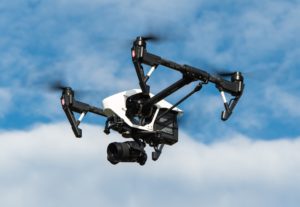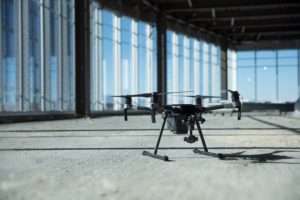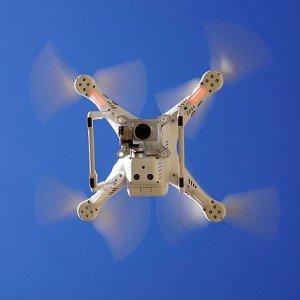In September, key players in the aviation industry highlighted the urgent need for standards and guidance in the face of the increasing and continued threat posed by unmanned aircraft systems (UAS), or drones as they are best known. IFSEC Global’s Julian Hall reports…
 Organisations including the Airport Council International (ACI) World, the Civil Air Navigation Services Organisation (CANSO), the International Federation of Air Traffic Controllers’ Associations (IFATCA), the International Federation of Air Line Pilots’ Associations (IFALPA) and the International Air Transport Association (IATA) presented a paper to the annual International Civil Aviation Organization (ICAO) Assembly that emphasised the need for ‘for harmonized regulatory provisions to facilitate a) detection of such unauthorized UAS operations and b) development of effective UAS countermeasures, in the interest of aviation safety.’
Organisations including the Airport Council International (ACI) World, the Civil Air Navigation Services Organisation (CANSO), the International Federation of Air Traffic Controllers’ Associations (IFATCA), the International Federation of Air Line Pilots’ Associations (IFALPA) and the International Air Transport Association (IATA) presented a paper to the annual International Civil Aviation Organization (ICAO) Assembly that emphasised the need for ‘for harmonized regulatory provisions to facilitate a) detection of such unauthorized UAS operations and b) development of effective UAS countermeasures, in the interest of aviation safety.’
Incidents involving drones are becoming more and more of a concern. One infamous example came before last Christmas at Gatwick Airport. It resulted in around 1,000 flights being delayed and affected 140,000 passengers. In July 2014, a drone narrowly missed colliding with an Airbus A320 as it was taking off from Heathrow airport. The Civil Aviation Authority (CAA) described the incident as involving a ‘serious risk of collision.’
Elsewhere, drone events have gone from shocking threats to catastrophic destruction. In 2014 a drone was deliberately crashed in front of Angela Merkel by the German Pirate Party. The intention was to protest about surveillance. Luckily, no one was hurt but it raised concerns about the harmful potential of UAS. A year later, a drone crashed onto the White House lawn. This year we saw an attack on Saudi Arabia’s oil pipelines, attributed to Houthi rebels and, earlier this year a Houthi attack on Yemeni military leaders. Last July, drones were cited as having attacked airports in Abu Dhabi and Kuwait.
Drone rules – how nations compare
 IATA has already issued operational guidance to states around the world to ‘ensure the safe and efficient integration of Unmanned Aircraft Systems (UAS) into shared airspace.’ The interpretation and execution of guidelines, of course, varies between nations.
IATA has already issued operational guidance to states around the world to ‘ensure the safe and efficient integration of Unmanned Aircraft Systems (UAS) into shared airspace.’ The interpretation and execution of guidelines, of course, varies between nations.
The European Commission recently adopted new rules to address safety and security issues relating to professional and leisure/amateur operators. The rules state that: ‘As of 2020 drone operators will have to be registered with national authorities.’ The Commission further says: “through operators’ registration, remote identification and definition of geographical zones, all national authorities will have means to prevent misuse or unlawful drone activities.” Among the measures are requirements that drones do not fly over 120 metres and that member states can define ‘no-fly zones’, “where – through satellite geo-location – drones will not be allowed to enter. ‘No-fly zones’ may include airports and airfields or city centres.”
In the UK, the government has just launched its Counter-Unmanned Aircraft Strategy and introduced the first reading of the Air Traffic Management and Unmanned Aircraft Bill. The former, led by security minister Brandon Lewis MP, includes a dedicated unit to detect and immobilise dangerous drones, while the latter, led by transport secretary Grant Shapps MP, requires airports to modernise their airspace and confront the drone threat, and it gives the government the ability to fine airports who do not respond fast enough. The bill also expands police powers in this area, including new stop-and-search powers.
The US have actually relaxed rules around UAS flights in the last three years, although leisure and professional users must register their drone with the Federal Aviation Authority.
Drone operators do not now have to pass a medical exam, nor do they have to have liability insurance, give a NOTAM (Notice To Airmen) flagging potential hazards to aviation authorities, or need a pilot’s licence (an aeronautical knowledge test will suffice).
Canada’s laws, meanwhile, seem a little more rigorous and dictate that pilots conducting basic and advanced operations need a pilot’s certificate, for which they need to pass an exam.
Australia’s regulations, meanwhile, are quite clear when it comes to avoiding traditional aerospace. Recreational drones must not be flown within 5.5 kilometres of any aerodrome, be that a controlled one in a city or town or a rural ‘uncontrolled’ one.
In Russia, according to the Russian Air Transport code, drone flights must be vetted by local branches of the Federal Air Transport Authority. Steep fines of over £10,000 could be imposed for any transgressions. Other rules include: day flights only; direct visual contact to be maintained by the user with the drone; no flying over congested areas, military installations or sites including the Kremlin and Red Square.
China has similar regulations, with all drones regulated by China’s ‘No-Fly-Zones’ (NFZs). Advance permission from the Civil Aviation Administration of China is required to fly in these zones.
These are snapshots of the current state of play, but the situation is fast moving given the technological advancements of UAS and the roles that drones can undertake. It’s no wonder that the aviation industry is agitating for more comprehension and cohesion.
Whither the drone?
 A chaotic picture of drone use was painted recently by James Rogers, Assistant Professor in War Studies at the University of Southern Denmark, and Visiting Research Fellow within the Department of International Security Studies at Yale University. He envisaged a world where drones of all shapes, sizes and weights “flow endlessly back and forth from rural distribution centers to inner-city delivery hubs” in their efforts to deliver any number of essentials, and non-essentials too.
A chaotic picture of drone use was painted recently by James Rogers, Assistant Professor in War Studies at the University of Southern Denmark, and Visiting Research Fellow within the Department of International Security Studies at Yale University. He envisaged a world where drones of all shapes, sizes and weights “flow endlessly back and forth from rural distribution centers to inner-city delivery hubs” in their efforts to deliver any number of essentials, and non-essentials too.
Writing in the Bulletin of the Atomic Scientists, Professor Rogers conjectures: “Drones might even pick us up from work (or the bar) and take us home in automated airborne Ubers. They will transform our lives. Hundreds, if not thousands, of drones will fly high above towns and cities, bypassing the congested highways and streets currently plagued by traffic.”
The professor also reflected on the potential weaponising of drones and how the negative and hostile use of them by bad actors threatens to undermine their positive and useful applications. Drones are both a threat to national infrastructure and, at the same time, are a vital part of that infrastructure.
In his concluding remarks, Rogers sounded alarm bells for the aviation industry and governments alike:
‘As one counter-drone expert recently warned, “very few airports have any countermeasures or even processes in place to detect and defeat drones,” and many existing technologies are underperforming or too risky to use. It will take a lot of work, and focused investment from authorities and industry, to create a safe and vibrant drone future—one that can harness the benefits of drones while keeping out the darker sides of the technology.’
[interaction id=”5dbc13207bf76b4c17bf795b”]
Why should you subscribe to the SHP newsletter?
Do you want the very latest health and safety news, product launches, job listings and expert opinions sent straight to your inbox daily?
The SHP newsletter is essential reading – sign up today to get your hands on all this!

 Organisations including the Airport Council International (ACI) World, the Civil Air Navigation Services Organisation (CANSO), the International Federation of Air Traffic Controllers’ Associations (IFATCA), the International Federation of Air Line Pilots’ Associations (IFALPA) and the International Air Transport Association (IATA) presented a paper to the annual International Civil Aviation Organization (ICAO) Assembly that emphasised the need for ‘for harmonized regulatory provisions to facilitate a) detection of such unauthorized UAS operations and b) development of effective UAS countermeasures, in the interest of aviation safety.’
Organisations including the Airport Council International (ACI) World, the Civil Air Navigation Services Organisation (CANSO), the International Federation of Air Traffic Controllers’ Associations (IFATCA), the International Federation of Air Line Pilots’ Associations (IFALPA) and the International Air Transport Association (IATA) presented a paper to the annual International Civil Aviation Organization (ICAO) Assembly that emphasised the need for ‘for harmonized regulatory provisions to facilitate a) detection of such unauthorized UAS operations and b) development of effective UAS countermeasures, in the interest of aviation safety.’ IATA has already issued operational guidance to states around the world to ‘ensure the safe and efficient integration of Unmanned Aircraft Systems (UAS) into shared airspace.’ The interpretation and execution of guidelines, of course, varies between nations.
IATA has already issued operational guidance to states around the world to ‘ensure the safe and efficient integration of Unmanned Aircraft Systems (UAS) into shared airspace.’ The interpretation and execution of guidelines, of course, varies between nations. A chaotic picture of drone use was painted recently by James Rogers, Assistant Professor in War Studies at the University of Southern Denmark, and Visiting Research Fellow within the Department of International Security Studies at Yale University. He envisaged a world where drones of all shapes, sizes and weights “flow endlessly back and forth from rural distribution centers to inner-city delivery hubs” in their efforts to deliver any number of essentials, and non-essentials too.
A chaotic picture of drone use was painted recently by James Rogers, Assistant Professor in War Studies at the University of Southern Denmark, and Visiting Research Fellow within the Department of International Security Studies at Yale University. He envisaged a world where drones of all shapes, sizes and weights “flow endlessly back and forth from rural distribution centers to inner-city delivery hubs” in their efforts to deliver any number of essentials, and non-essentials too.